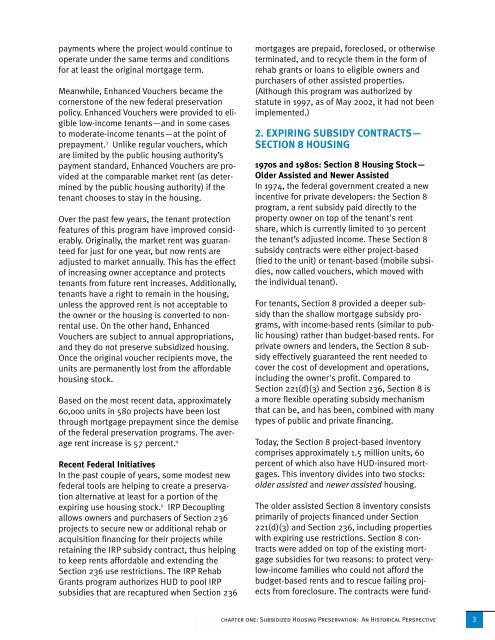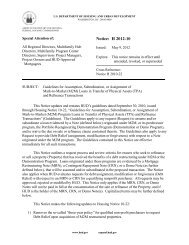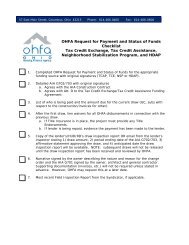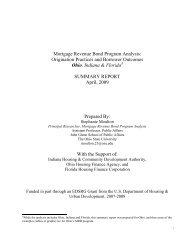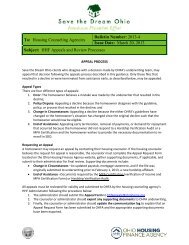lis 217 stemming the tide - LISC
lis 217 stemming the tide - LISC
lis 217 stemming the tide - LISC
- No tags were found...
Create successful ePaper yourself
Turn your PDF publications into a flip-book with our unique Google optimized e-Paper software.
payments where <strong>the</strong> project would continue tooperate under <strong>the</strong> same terms and conditionsfor at least <strong>the</strong> original mortgage term.Meanwhile, Enhanced Vouchers became <strong>the</strong>cornerstone of <strong>the</strong> new federal preservationpolicy. Enhanced Vouchers were provided to eligiblelow-income tenants—and in some casesto moderate-income tenants—at <strong>the</strong> point ofprepayment. 3 Unlike regular vouchers, whichare limited by <strong>the</strong> public housing authority’spayment standard, Enhanced Vouchers are providedat <strong>the</strong> comparable market rent (as determinedby <strong>the</strong> public housing authority) if <strong>the</strong>tenant chooses to stay in <strong>the</strong> housing.Over <strong>the</strong> past few years, <strong>the</strong> tenant protectionfeatures of this program have improved considerably.Originally, <strong>the</strong> market rent was guaranteedfor just for one year, but now rents areadjusted to market annually. This has <strong>the</strong> effectof increasing owner acceptance and protectstenants from future rent increases. Additionally,tenants have a right to remain in <strong>the</strong> housing,unless <strong>the</strong> approved rent is not acceptable to<strong>the</strong> owner or <strong>the</strong> housing is converted to nonrentaluse. On <strong>the</strong> o<strong>the</strong>r hand, EnhancedVouchers are subject to annual appropriations,and <strong>the</strong>y do not preserve subsidized housing.Once <strong>the</strong> original voucher recipients move, <strong>the</strong>units are permanently lost from <strong>the</strong> affordablehousing stock.Based on <strong>the</strong> most recent data, approximately60,000 units in 580 projects have been lostthrough mortgage prepayment since <strong>the</strong> demiseof <strong>the</strong> federal preservation programs. The averagerent increase is 57 percent. 4Recent Federal InitiativesIn <strong>the</strong> past couple of years, some modest newfederal tools are helping to create a preservationalternative at least for a portion of <strong>the</strong>expiring use housing stock. 5 IRP Decouplingallows owners and purchasers of Section 236projects to secure new or additional rehab oracquisition financing for <strong>the</strong>ir projects whileretaining <strong>the</strong> IRP subsidy contract, thus helpingto keep rents affordable and extending <strong>the</strong>Section 236 use restrictions. The IRP RehabGrants program authorizes HUD to pool IRPsubsidies that are recaptured when Section 236mortgages are prepaid, foreclosed, or o<strong>the</strong>rwiseterminated, and to recycle <strong>the</strong>m in <strong>the</strong> form ofrehab grants or loans to eligible owners andpurchasers of o<strong>the</strong>r assisted properties.(Although this program was authorized bystatute in 1997, as of May 2002, it had not beenimplemented.)2. EXPIRING SUBSIDY CONTRACTS—SECTION 8 HOUSING1970s and 1980s: Section 8 Housing Stock—Older Assisted and Newer AssistedIn 1974, <strong>the</strong> federal government created a newincentive for private developers: <strong>the</strong> Section 8program, a rent subsidy paid directly to <strong>the</strong>property owner on top of <strong>the</strong> tenant's rentshare, which is currently limited to 30 percent<strong>the</strong> tenant’s adjusted income. These Section 8subsidy contracts were ei<strong>the</strong>r project-based(tied to <strong>the</strong> unit) or tenant-based (mobile subsidies,now called vouchers, which moved with<strong>the</strong> individual tenant).For tenants, Section 8 provided a deeper subsidythan <strong>the</strong> shallow mortgage subsidy programs,with income-based rents (similar to publichousing) ra<strong>the</strong>r than budget-based rents. Forprivate owners and lenders, <strong>the</strong> Section 8 subsidyeffectively guaranteed <strong>the</strong> rent needed tocover <strong>the</strong> cost of development and operations,including <strong>the</strong> owner's profit. Compared toSection 221(d)(3) and Section 236, Section 8 isa more flexible operating subsidy mechanismthat can be, and has been, combined with manytypes of public and private financing.Today, <strong>the</strong> Section 8 project-based inventorycomprises approximately 1.5 million units, 60percent of which also have HUD-insured mortgages.This inventory divides into two stocks:older assisted and newer assisted housing.The older assisted Section 8 inventory consistsprimarily of projects financed under Section221(d)(3) and Section 236, including propertieswith expiring use restrictions. Section 8 contractswere added on top of <strong>the</strong> existing mortgagesubsidies for two reasons: to protect verylow-incomefamilies who could not afford <strong>the</strong>budget-based rents and to rescue failing projectsfrom foreclosure. The contracts were fundchapterone: Subsidized Housing Preservation: An Historical Perspective3


